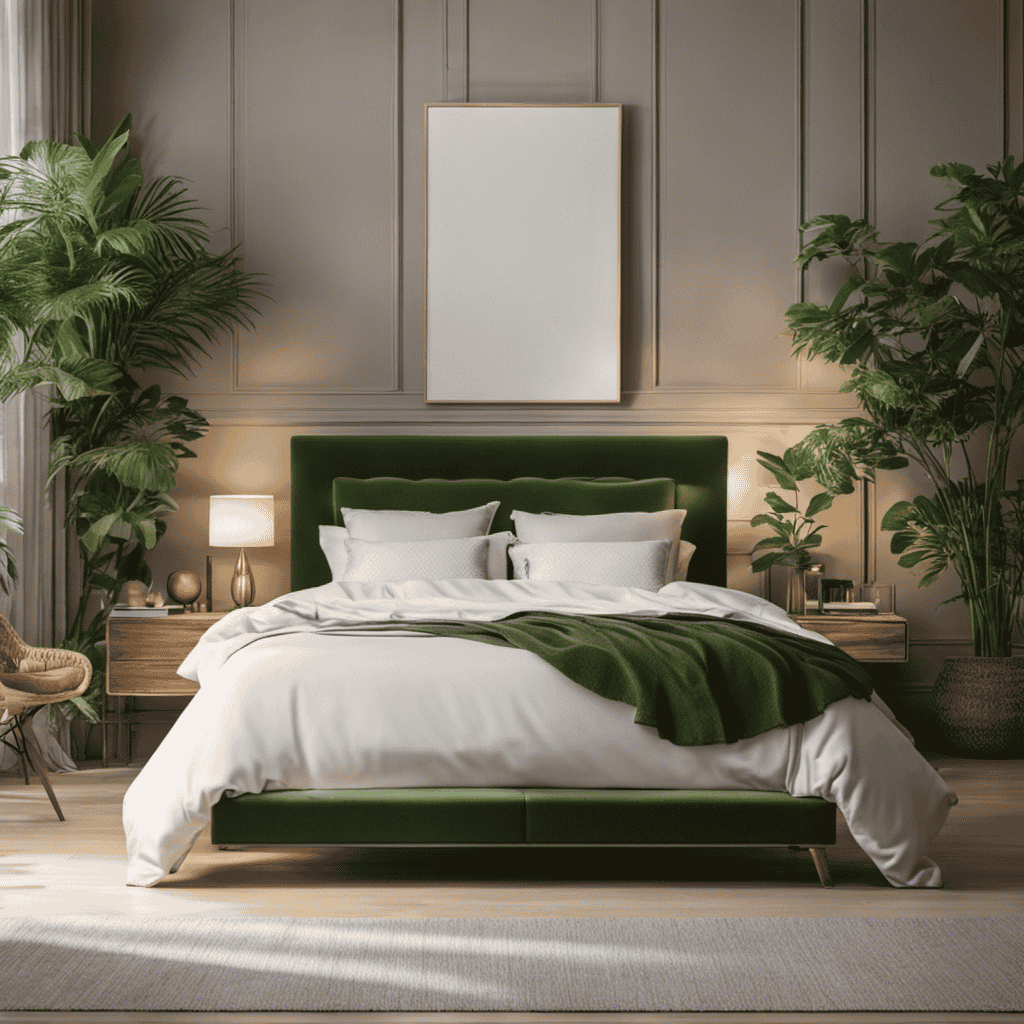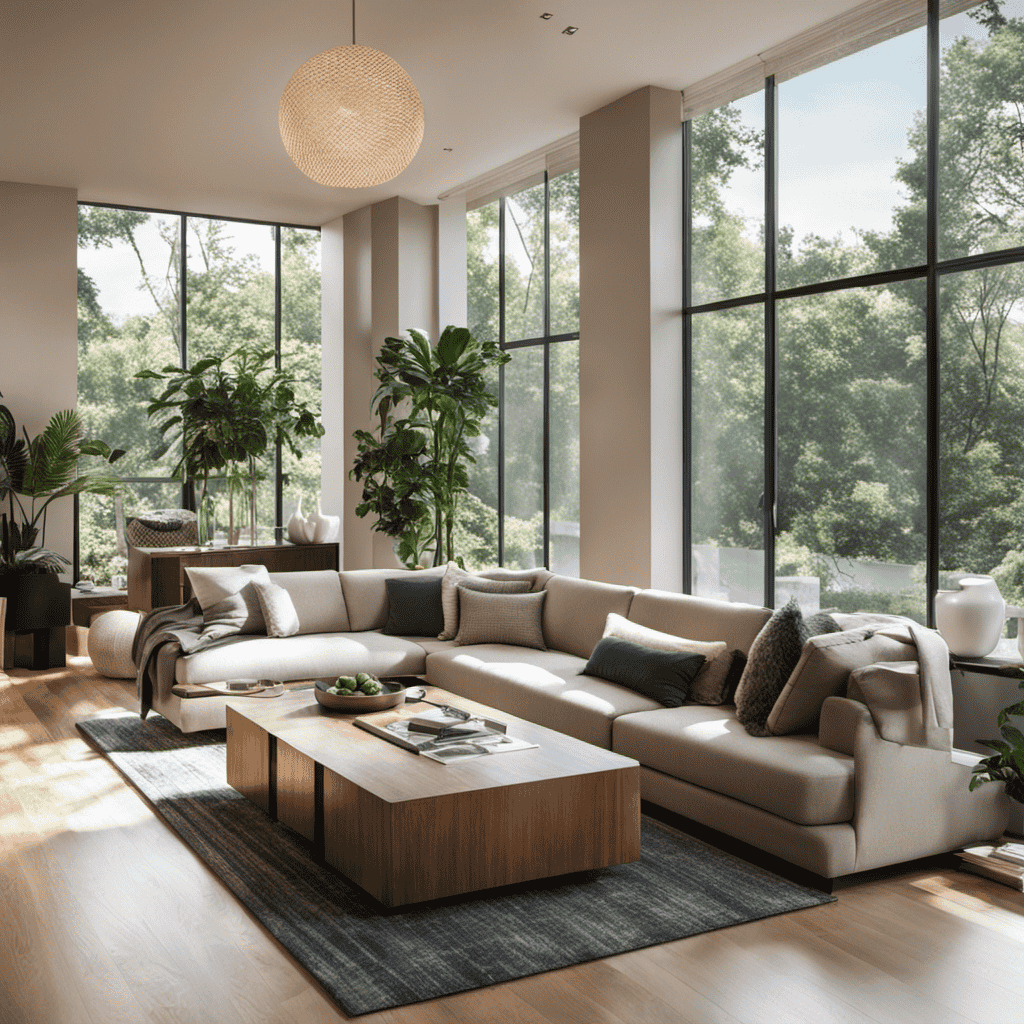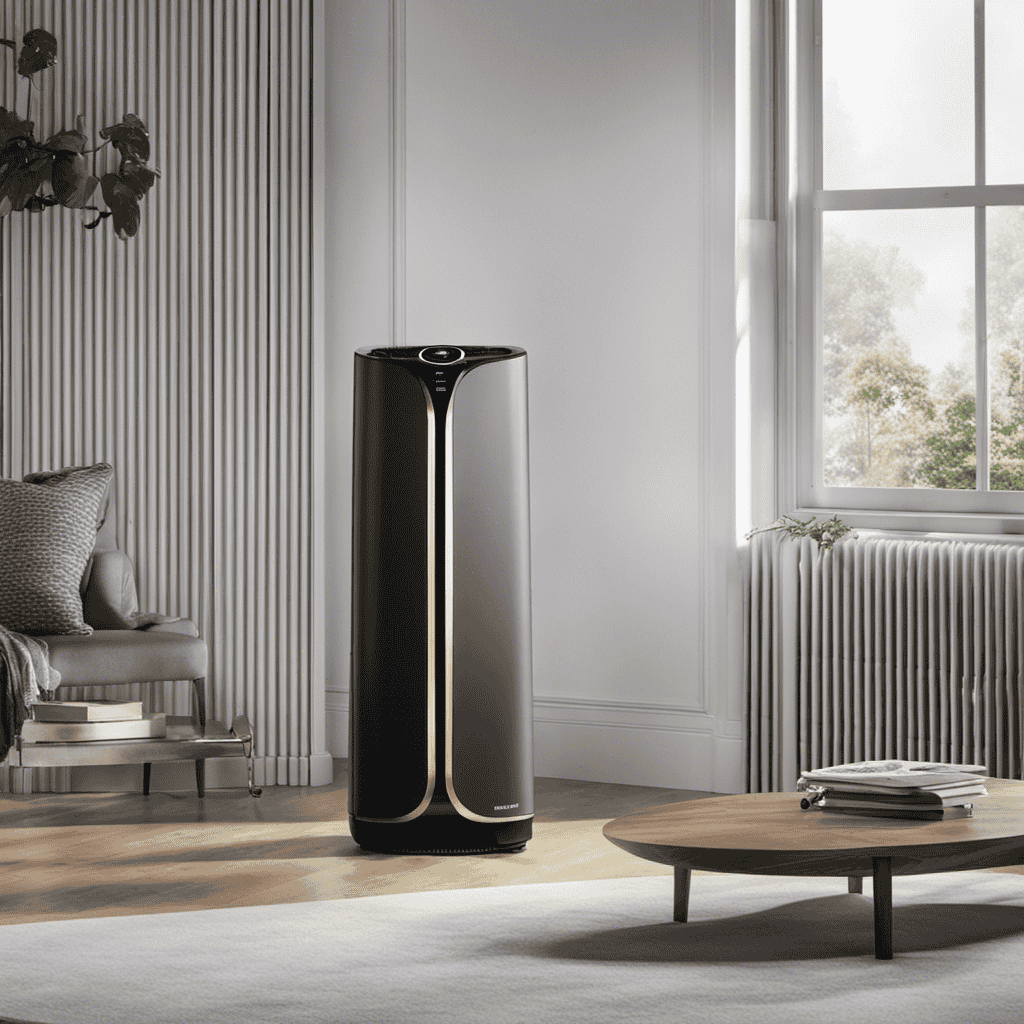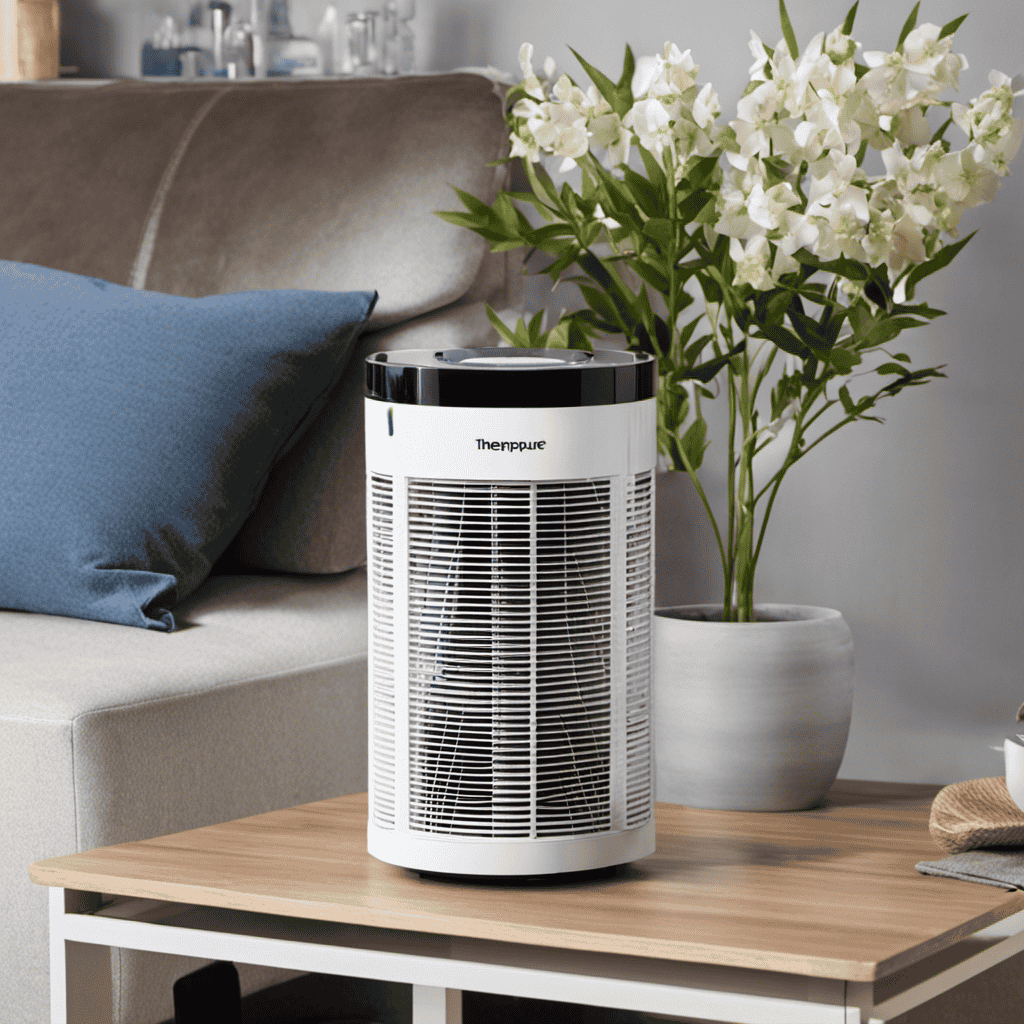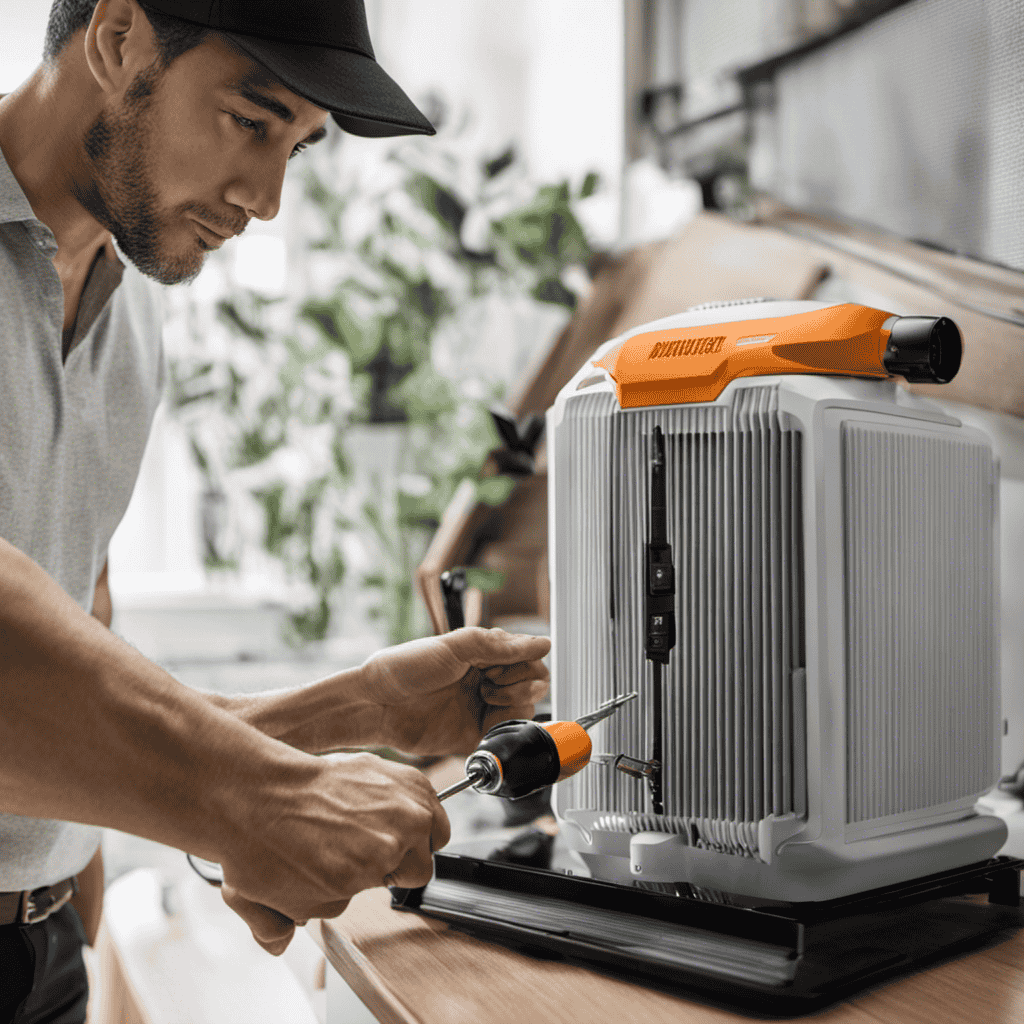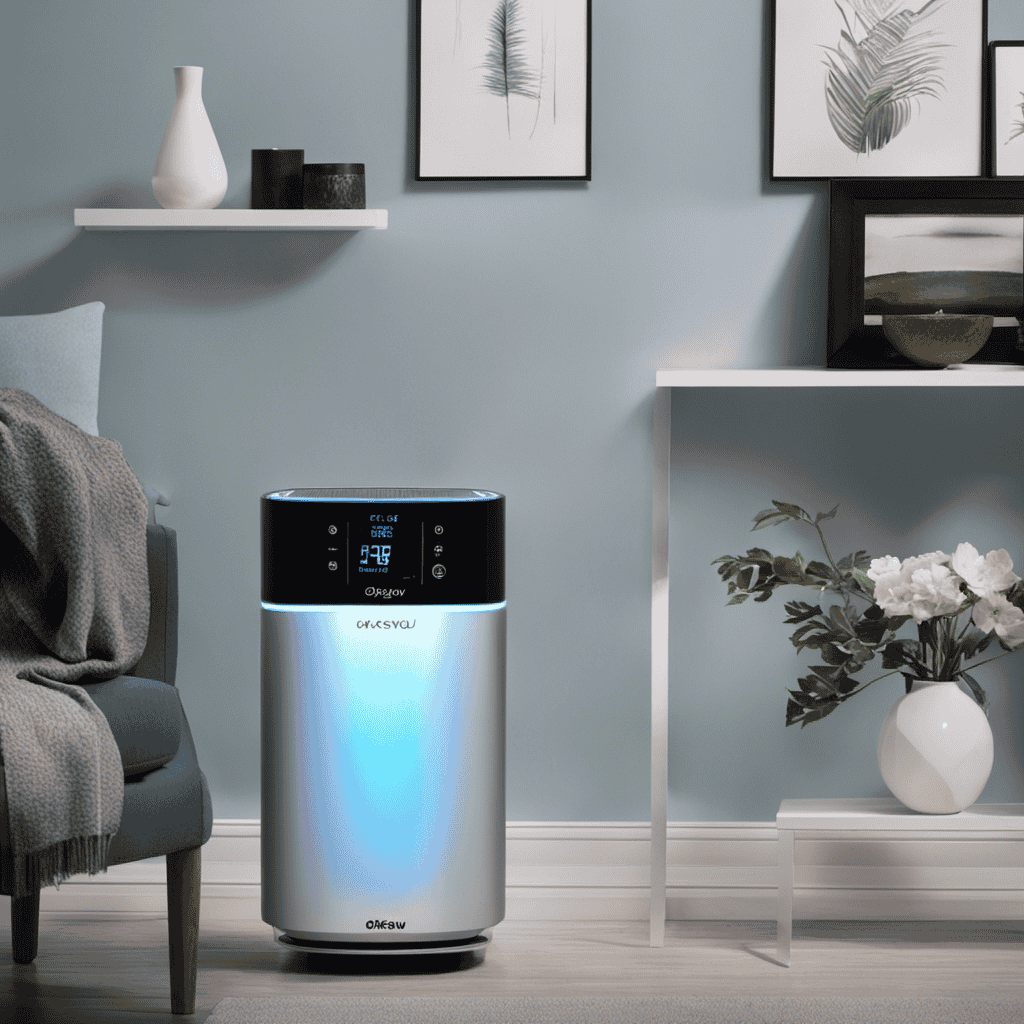Sitting here and taking a deep breath, I am reminded of the importance of having clean air in our homes. So, where should we place an air purifier? That’s the question we will address in this article.
With a knowledgeable and informative approach, we’ll explore various rooms in the house, from the bedroom to the basement, and even those pesky allergy hotspots.
So, let’s dive in and discover the optimal placement for your air purifier, ensuring you breathe easy wherever you are.
Key Takeaways
- The bedroom is an ideal location for an air purifier as it can improve air quality while sleeping, remove allergens, reduce the risk of respiratory issues and allergies, and eliminate unpleasant odors.
- In the living room, placing an air purifier can help remove harmful pollutants, eliminate odors, and improve air quality. Consider the size of the room and specific features like HEPA filters or carbon filters when choosing an air purifier.
- Placing an air purifier in the kitchen can help remove cooking odors, reduce airborne pollutants, eliminate harmful gases, and improve overall air quality. Look for features like UV-C technology to prevent the spread of germs.
- For a home office, it is important to place the air purifier where it can effectively circulate and filter the air. Consider the specific pollutants present in the office and choose an air purifier with appropriate filtration capabilities. Regular maintenance and filter replacement are crucial for optimal performance.
The Bedroom
You should consider putting the air purifier in your bedroom because it can help improve the air quality while you sleep. Maintaining the air purifier in your bedroom is crucial for its effectiveness. Regular maintenance, such as cleaning or replacing the filters, ensures that the air purifier continues to remove pollutants effectively.
By having an air purifier in your bedroom, you can experience numerous benefits. It helps to remove allergens like dust, pollen, and pet dander, reducing the risk of respiratory issues and allergies. Additionally, it eliminates unpleasant odors, creating a fresh and clean environment for a restful sleep.
Transitioning to the next section, placing an air purifier in the living room can further enhance the air quality throughout your home.
The Living Room
The living room is a great spot to place an air purifier. Not only is it a central area where we spend a significant amount of time, but it is also where we entertain guests and relax after a long day. Using an air purifier in the living room can provide numerous benefits. Firstly, it helps to remove harmful pollutants such as dust, pet dander, and pollen, improving the overall air quality and reducing allergy symptoms. Secondly, it eliminates unpleasant odors, making the room more inviting. When choosing an air purifier for your living room, consider the size of the room and the specific features you need, such as a HEPA filter for effective particle removal or a carbon filter for odor elimination. Transitioning into the subsequent section about ‘the kitchen’, we can explore how an air purifier can be beneficial in this area as well.
| Benefits | Tips for Choosing |
|---|---|
| Removes harmful pollutants | Consider the size of the room |
| Eliminates unpleasant odors | Look for HEPA filter or carbon filter |
| Improves overall air quality | Consider specific features needed |
The Kitchen
In the kitchen, it’s important to keep the air clean and fresh, especially with all the cooking and food preparation happening in this space. Kitchen air purification is crucial for maintaining a healthy environment. One effective way to achieve this is by using air purifiers.
Here are some benefits of air purifiers in the kitchen:
-
Removes cooking odors: Air purifiers are equipped with filters that can capture and eliminate unpleasant odors, making the kitchen smell fresh and clean.
-
Reduces airborne pollutants: Air purifiers can remove airborne particles like dust, pollen, and pet dander, improving indoor air quality and reducing the risk of allergies and respiratory issues.
-
Eliminates harmful gases: Some air purifiers are designed to remove harmful gases such as carbon monoxide and formaldehyde, which can be released during cooking.
-
Prevents the spread of germs: Air purifiers with UV-C technology can help kill airborne germs and prevent the spread of illnesses.
Investing in an air purifier for the kitchen can greatly improve the overall air quality, creating a healthier and more pleasant cooking environment.
The Home Office
When it comes to optimal air purification placement in the home office, there are a few key factors to consider.
First, it’s important to place the air purifier in a location where it can effectively circulate and filter the air. This means avoiding areas with obstructions or poor airflow.
Second, consider the specific pollutants that may be present in your home office, such as dust, allergens, or volatile organic compounds (VOCs), and choose an air purifier with appropriate filtration capabilities.
Lastly, remember that regular maintenance and filter replacement are crucial for maintaining optimal air quality in your workspace.
Optimal Air Purification Placement
For optimal air purification, it’s important to consider the placement of your air purifier. Proper placement can greatly enhance the efficiency and effectiveness of your device, ensuring that you breathe in clean and fresh air. Here are some key factors to keep in mind when deciding where to put your air purifier:
- Distance: Place the purifier in a central location to allow air circulation throughout the room.
- Height: Position the device at a height that allows it to capture airborne particles effectively.
- Obstructions: Avoid placing the purifier behind furniture or near curtains, as this can hinder airflow.
- Proximity: Keep the purifier away from sources of pollutants, such as smoking areas or kitchens.
By following these guidelines, you can maximize the performance of your air purifier and create a healthier environment in your home.
Now, let’s explore how air quality can be further improved.
Air Quality Improvement
Now that we have discussed the optimal placement for air purifiers, let’s delve into the importance of air purifier maintenance and the benefits it brings.
Regular maintenance of your air purifier is crucial to ensure its effectiveness in improving air quality. Cleaning or replacing filters, checking the fan and motor, and keeping the unit free from dust and debris are essential tasks. By maintaining your air purifier, you can prolong its lifespan and maximize its performance.
The benefits of air purifiers are numerous. First and foremost, they help to remove pollutants and allergens from the air, providing cleaner and healthier indoor air quality. This is especially beneficial for individuals with allergies, asthma, or other respiratory conditions.
Air purifiers can also eliminate unpleasant odors and neutralize harmful chemicals and VOCs (volatile organic compounds). Additionally, they can help reduce the spread of airborne viruses and bacteria, creating a safer and more hygienic environment.
With proper maintenance, your air purifier can provide you with these benefits and improve the overall air quality in your home or office.
The Nursery
The nursery is a great place to put an air purifier because it helps to keep the air clean and fresh for the baby. As a parent, ensuring a safe and healthy environment for my child is a top priority. Here are four reasons why an air purifier is essential in a nursery:
-
Eliminates pet dander and allergens: Air purifiers with HEPA filters effectively capture pet dander, hair, and other allergens, making it ideal for families with pets.
-
Reduces asthma triggers: Air purifiers can filter out common asthma triggers like dust mites, pollen, and mold spores, providing relief to children with asthma.
-
Removes harmful chemicals and odors: Some air purifiers have activated carbon filters that can remove volatile organic compounds (VOCs) and unpleasant odors from cleaning products or paints, ensuring a healthier indoor environment.
-
Promotes better sleep: Air purifiers create a peaceful and clean atmosphere, reducing potential disturbances and helping babies and parents sleep better.
The Basement
When it comes to the basement, proper air circulation is crucial for maintaining a healthy and odor-free environment.
To ensure adequate airflow, it is important to keep the basement windows open whenever possible and use fans or dehumidifiers to promote air movement.
Additionally, eliminating basement odors can be achieved by identifying and addressing the source, such as mold or mildew, and implementing proper ventilation and cleaning techniques.
Air Circulation in Basement
To improve air circulation in the basement, you should consider placing the air purifier near a window or doorway. This will allow the purifier to draw in fresh air from outside and circulate it throughout the space.
In addition to proper placement, regular air purifier maintenance is crucial to ensure optimal performance. Here are some tips for maintaining your air purifier:
- Clean or replace the filters regularly to remove dust, allergens, and other pollutants.
- Keep the vents and grilles free from obstructions to allow for proper airflow.
- Wipe down the exterior of the purifier with a damp cloth to remove any dirt or dust buildup.
- Consider using a vacuum cleaner with a HEPA filter to clean the surrounding area and remove any airborne particles.
Choosing the right air purifier for your basement is also important. Look for one with a high CADR (Clean Air Delivery Rate) and a suitable coverage area for your space.
Eliminating Basement Odors
Eliminating basement odors can be achieved by using odor-eliminating sprays or opening windows to increase ventilation. Musty odors in basements are often caused by the presence of mold and mildew, which thrive in damp and poorly ventilated areas. To prevent mold growth and eliminate musty odors, it is important to address the root cause of the problem.
This can be done by reducing moisture levels in the basement through proper insulation, dehumidification, and waterproofing. Additionally, regular cleaning and maintenance of the basement, including vacuuming and wiping down surfaces, can help eliminate odors. Using air purifiers with activated carbon filters can also be effective in removing odors from the air.
By taking these steps, you can create a clean and fresh-smelling basement, free from musty odors and the potential for mold growth.
Transition: Now that we have discussed eliminating basement odors, let’s explore the next topic – the allergy hotspots.
The Allergy Hotspots
One of the best spots for an air purifier is in the bedroom, where allergies tend to be most prominent. Having an air purifier in your bedroom can provide numerous benefits and improve your overall sleep quality. Here are some reasons why:
-
Reduction of allergens: An air purifier filters out common allergens like dust mites, pollen, and pet dander, helping to alleviate allergy symptoms.
-
Improved air quality: Air purifiers remove pollutants and toxins from the air, ensuring you breathe in clean and fresh air.
-
Odor elimination: Air purifiers can effectively eliminate unpleasant odors, making your bedroom smell fresh and clean.
-
Peaceful sleep: With cleaner air and reduced allergens, you can enjoy a restful night’s sleep without interruptions from coughing or sneezing.
To ensure your air purifier works efficiently, regular maintenance is crucial. This includes cleaning or replacing filters, checking the unit for any signs of damage, and scheduling professional servicing if needed. By properly maintaining your air purifier, you can maximize its performance and prolong its lifespan.
What Are the Benefits of Putting an Air Purifier in Different Locations?
The best place for air purifier in your home is the bedroom, to ensure clean air while you sleep. In the kitchen, an air purifier can help remove cooking odors and improve indoor air quality. Placing one in your home office can help reduce indoor air pollutants and promote a healthy work environment.
Frequently Asked Questions
How Often Should I Replace the Filters in My Air Purifier?
I replace the filters in my air purifier every 3-6 months, depending on the manufacturer’s recommendations. It’s important to follow their guidelines for optimal performance. Cleaning filters can help extend their lifespan, but eventually, replacement is necessary.
Can an Air Purifier Help With Pet Allergies?
An air purifier can be effective in reducing pet allergies. It filters out pet dander and other allergens, providing relief for allergy sufferers. Placing it in the room where you spend the most time is recommended.
Does an Air Purifier Eliminate Odors From Cooking?
Eliminating odors from cooking requires an air purifier strategically placed in the kitchen. It reduces indoor air pollution, giving a breath of fresh air. But remember, for cigarette smoke, better to have it closer.
Can I Run an Air Purifier All Day and Night?
I can run an air purifier all day and night to continuously clean the air. However, it’s important to consider the noise it produces. Placing it in a central area can help distribute clean air throughout the room.
Is It Necessary to Have Multiple Air Purifiers for Different Rooms in My House?
It’s important to have multiple air purifiers for different rooms in your house. This maximizes the effectiveness of the purifiers and ensures that each room receives the full benefits of clean air.
Conclusion
After considering all the factors, it’s clear that the best place to put an air purifier depends on the specific needs of each individual.
For those who suffer from allergies, placing the purifier in the bedroom or living room can greatly improve air quality and provide relief.
In a home office, purifiers can help remove pollutants and increase productivity.
The kitchen is another important area, as it can harbor odors and cooking fumes.
When it comes to the nursery, ensuring clean air is crucial for the health of a newborn.
Finally, basements and allergy hotspots should not be overlooked, as they can be breeding grounds for mold and other allergens.
Ultimately, placing air purifiers strategically throughout the home can create a healthier and more comfortable living environment.
